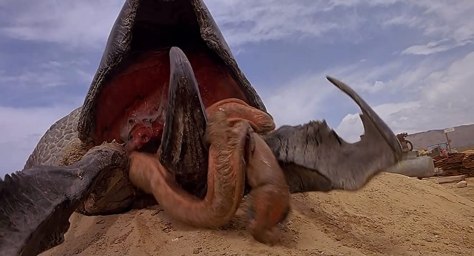
Big Hollywood studios have a hot-and-cold relationship with monster movies—they’ll cede that territory to B-movie productions for years, or decades, at a time, and then start investing some bigger budgets into a select few before dropping the whole thing again. The nineties was one of those periods with a minor streak of classic-style creature features—”classic-style” in the sense that they’re more or less following the structures that were laid down in the fifties. Their special effects may be more sophisticated, the dialogue less stiff and expository, and the violence more explicit, but in the end it’s still a movie where a group of people have to deal with the sudden appearance of a monster or monsters, and the expected plot beats are barely changed, even after forty years.
Tremors, which could be considered the first in that wave, wasn’t a significant success in its original release, and likely accrued its cult following through home video and TV airings, leading it to become a direct-to-video franchise with a surprising amount of longevity (as in, it’s most recent sequel came out in 2020)—it even had a short-lived TV show, and a more recent series attempt that wasn’t picked up. Technically, it’s also an end-of-the-eighties movie that was delayed into the dead early months of 1990, just like Nightbreed, making it something of a liminal artifact. Looking at it now, you can see how it heralds some of the ways the subsequent decade of monster movies attempted to differentiate themselves from their predecessors, some minor tweaks in presentation likely meant to pull in new audiences—while Tremors and what followed tended to resemble the old school entries in basic plotting, they change just enough of the surface details to make themselves feel contemporary, with a particular emphasis on comedy.
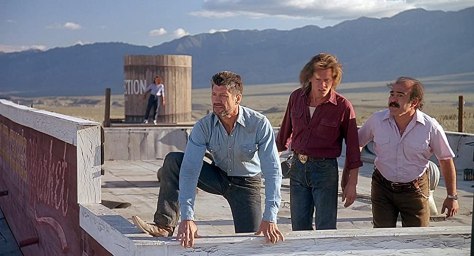
Comedy was, and is, one of the ways that many monster movies made past a certain point—let’s say the end of the seventies—could shield themselves from the critical and audience ridicule that the genre had been met with for years, letting everyone know that the movies themselves were in on the joke. In the eighties, maximum absurdity was regularly embraced, with a movie like Gremlins taking a meta, self-aware swerve, while others like Q – The Winged Serpent go full gonzo. Tremors is probably closer to the latter than the former, but in truth it’s far more mainstream-friendly, based in lightly exaggerated characters and comical conversations, all while treating the monster stuff relatively seriously. There’s nothing particularly satirical or self-aware about this movie as it presents a weird situation that some wacky people find themselves in—a relatively straightforward genre scenario that could probably be expected from the screenwriter team behind Short Circuit and director Ron Underwood, best known for City Slickers, although he’d also go on to direct the 1998 remake of Mighty Joe Young as well.
Casting southern-fried lunkheads Val (Kevin Bacon) and Earl (Fred Ward) as our protagonists cements the tone of the movie from the beginning. These two are portrayed as luckless dopes who frequently get into petty arguments, but they’re still practical enough that they don’t make bone-headed movie character mistakes when the action starts (which would make them more annoying than endearing), and strive for the believably mundane dream of no longer having to perform thankless odd jobs in a small Nevada town. They are the average joes who are forced to take charge when the situation calls for it, which makes them a little bit more relatable than the legions of scientists, military brass, and journalists who were given the lead roles in the older monster movies—I can feel a bit of Stephen King influence in this, a willingness to place horror in a more down-to-earth context (I can also see a slight resemblance in set-up between Tremors and King’s own Maximum Overdrive, although the former is more coherent and less scrambled by cocaine-addled creative decisions.) There’s a low-key, likeable scuzziness to the whole setting, a well-meaning if still still slightly condescending view of rural America with its dingy general stores, trailers, and “colourful” locals—more lighthearted than the Gothic-tinged vision of rural folk seen in something like Pumpkinhead (fun fact: Tremors creature effects co-creator Tom Woodruff Jr. was the one in the Pumpkinhead suit), and just two-dimensional enough that they never come off as flat caricatures.

This is all carried by a good cast who can match the material, if not elevate it. Bacon and Ward effectively pull off both the comedic and action hero sides of their hero roles, Finn Carter as the seismologist who detects the first sign of monster business makes a decent foil for them (although as the scientist she still has to fill the standard role of the exposition machine), and it’s fun to see Victor Wong there as the slightly self-serving general store proprietor. Is it a bit of an obvious joke to have Family Ties‘ Michael Gross and country star Reba McEntire play a married couple of gun nut survivalists? Yes, but they’re still enjoyable. This is one of those movies that has violence and mean jokes but clearly doesn’t want to come off as too mean, and surprisingly most of our core cast of characters remain relatively unscathed to the very end of the movie. It doesn’t even have the stomach to off the designated annoying teenager character! Compared to the sadism and high body count of a lot of eighties horror, this comes off as fairly tame.
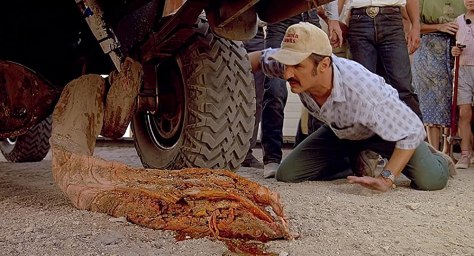
Which is not to say that they skimped on the horror of the monster scenes or the sense of tension—I’d say that the main reasons why this movie gained a following is because of its well-realized monsters. These days, a sand worm is nothing new or interesting, but outside of Dune, seeing something like that on screen was a rare sight in 1990—and like a miniature version of Dune’s sand worms, the so-called Graboids (an intentionally ludicrous name coined by Victor Wong’s character) effectively play into a fear of something tracking us beneath our feet. The script was written under the working title “Land Sharks”, and that’s how these worms are played: swimming through the dirt (the credits list the amusing position of “Dirt Wrangler”) at incredible speeds and zoning in on the closest target to attack from below, many scenes use the image of our cast stranded on rocks or roofs, unable to touch the ground, knowing that the things are there. Like many of the better movies I’ve written about, this takes advantage of the desert setting (obviously filmed in California and not Nevada, but who of us outside the US Southwest can tell?) to create dread in wide open spaces, and in this case, the script also lightly plays up the isolation of a small town, far away from the kinds of authorities who might be able to help in a situation like this.

The design of the Graboids is a perfect bit of streamlined monster menace: while a giant worm would be scary enough, this one has a big, beaked mouth that opens to reveal several, snake-like extensions with their own cute, Muppet-y mouths. Those mouths-within-mouths are the first things that we see of the Graboids, and fake us out into thinking there are several smaller monsters rather than a few gigantic ones. Aside from the aforementioned Dune worms, there are hints of Alien in it, maybe a bit of Audrey II from Little Shop of Horrors—and we get many good looks at it throughout the movie, in broad daylight, a bit of confidence in the puppets that other reviews I’ve read (including contemporaneous and near-contemporaneous ones) were particularly impressed by. As much as people have come to appreciate the additional subtlety that hiding a monster in shadows provides, they also recognize that “subtlety” is often synonymous with “cheapness”, and this is a movie that has no real time for subtlety or cheapness.

In reality, the primary impetus for studios to bankroll Tremors and the creature features that followed was likely the proliferation of talented special effects houses and the burning desire to flex the relative “realism” that could be achieved, first through complicated animatronics (as in this movie), and later with the addition of CGI. The Tremors effects team led by Woodruff Jr. and Alec Gillis, alumni of Stan Winston’s studio, really bring this specific concept to life in a way that could only be done in this era, and the visual spectacle is the main draw of the movie—everything else just has to be agreeable enough to supplement rather than supplant the appeal of seeing these grotesque worms dig and chomp their way through small town America.

Tremors tends to focus on the stuff that benefits the moment-to-moment action, but isn’t particularly concerned with the details—and even makes jokes about it. Like a classic movie monster, the Graboids just start killing people out of nowhere, and no explanation is provided for where they came from—in one scene, Val, Earl, and the seismologist speculate on their origins, naming off three generic monster backstories (aliens, radioactive mutants, or prehistoric throwbacks) and never settling on any of them. Their physical characteristics are well-defined, but the logic is not: there’s the big question of what these very large animals have been living on before suddenly deciding to hunt on the surface, and the suggestion that they “predate the fossil record” doesn’t really make any sense. I guess the Graboids are kept just vague enough that it allows the movie to avoid extraneous explanation, and to play with how intelligent they are. The way every other character immediately asks the one scientist to explain what they’re doing, even though she’s not a biologist, is a running joke.
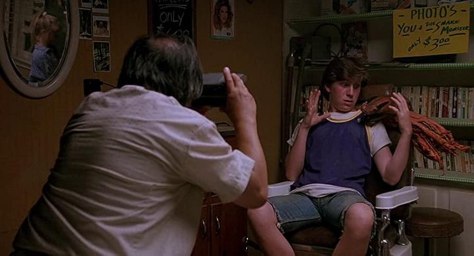
The script moves fairly quickly, and each scene introduces new complications even as our heroes seemingly figure out or overcome the methods of the Graboids—how they detect things through vibrations, and how they can’t bore through solid rock. The early death scenes involve people, and even cars, being sucked down into the sand; by the middle of the movie, the worms are bursting through the floors of buildings and even figure out how to destroy the foundation to make those buildings collapse; and in the finale, it becomes a series of chases as our cast attempt to distract the Graboids while escaping using whatever rusted vehicles and tools they can find strewn across the town. Its momentum comes from a genuine understanding of its setting, characters, and its monsters, and in keeping with its lighter tone, these scenes feel as much like some rousing adventure story as much as a more traditional base-under-siege monster movie.
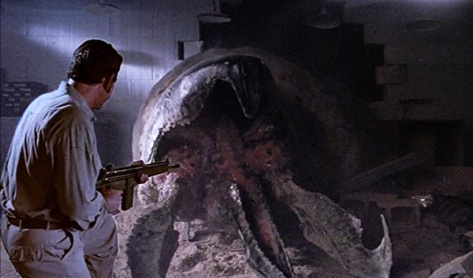
This particular blend of elements is a tough needle to thread—and Tremors makes it work mainly by keeping everything simple. It’s never too serious or too campy, and its monstrous threat is never undermined by the comedy, even if the movie does enjoy playing up the grossness of them. It’s probably as good a modernization of the classic formulas as you could expect, but with most creative ambitions left off to the side—this is simply an exaggerated man against nature story with snappy dialogue. It succeeds in this case because all the different pieces work together, and it presages the oncoming decade through its slickness and savvy rather than by addressing some pressing concerns. How much juice this surface-level model had in the long term, though, was another question.
